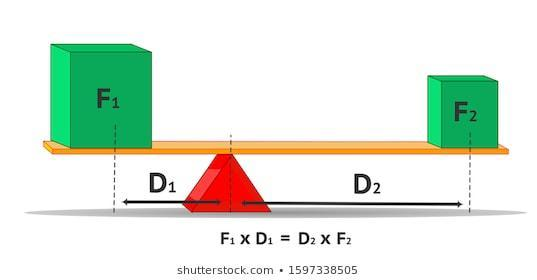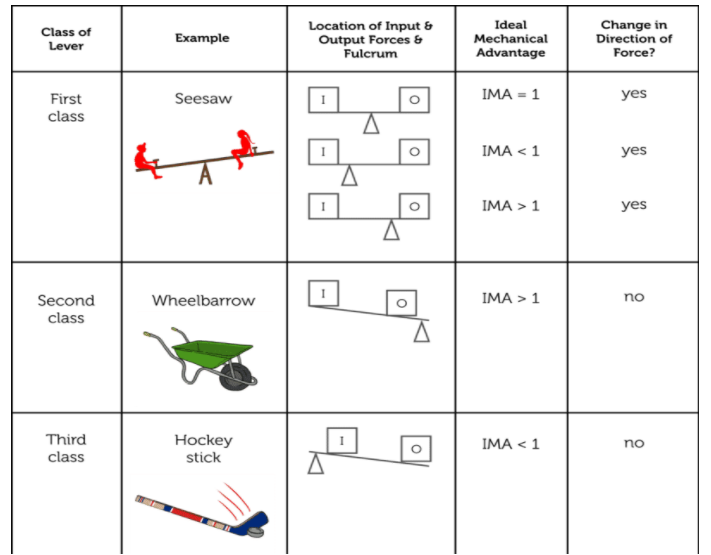
Which class of lever always has \[M.A.>1\] and why?
Answer
579k+ views
Hint: A lever is a simple machine consisting of a bar that rotates around a fixed point called the fulcrum. \[M.A.\] of a lever is the mechanical advantage of a lever which is given as by dividing the distance from the fulcrum to the applied force by the distance from the fulcrum to the resistance force.
Complete step by step answer:
First of all, we must know that there are three basic classes of lever, called first-class, second-class, and third-class. A lever consists of a bar that rotates around a fulcrum. The mechanical advantage of a system is given by,
\[M.A.=\dfrac{{{f}_{input}}}{{{f}_{output}}}\]

Then, in this case, \[M.A.=\dfrac{{{F}_{e}}}{{{F}_{r}}}\].
Now, let us compare all three classes of levers by analyzing the given figure,
In the first-class levers, the input force and output forces are on opposite sides of the fulcrum, the lever changes the direction of applied force. As both forces are the same distance from the fulcrum, the input distance equals to the output distance. So, the mechanical advantage will be equal to 1. i.e. \[M.A.=1\].
For both second and third class levers, the input and output forces are on the same side of the fulcrum, so the direction of applied force doesn’t change. In second-class levers, the input force applied is always farther from the fulcrum, I.e. the input distance is greater than the output distance, so the mechanical advantage will be always greater than 1. i.e. \[M.A.>1\].

In the case of third-class levers, the input force applied is closer, so the input distance is less than the output distance. So the mechanical advantage will always be less than 1. i.e. \[M.A.<1\].
So, we can conclude that second-class levers will always have the mechanical advantage greater than 1.
Note:
In the case of levers, only a first-class lever changes the direction of the force. Even the \[M.A.<1\] for the third-class lever, there is an advantage of using them that the output force is applied over a greater distance than input force which means that the output end of the lever moves faster than the input end.
Complete step by step answer:
First of all, we must know that there are three basic classes of lever, called first-class, second-class, and third-class. A lever consists of a bar that rotates around a fulcrum. The mechanical advantage of a system is given by,
\[M.A.=\dfrac{{{f}_{input}}}{{{f}_{output}}}\]

Then, in this case, \[M.A.=\dfrac{{{F}_{e}}}{{{F}_{r}}}\].
Now, let us compare all three classes of levers by analyzing the given figure,
In the first-class levers, the input force and output forces are on opposite sides of the fulcrum, the lever changes the direction of applied force. As both forces are the same distance from the fulcrum, the input distance equals to the output distance. So, the mechanical advantage will be equal to 1. i.e. \[M.A.=1\].
For both second and third class levers, the input and output forces are on the same side of the fulcrum, so the direction of applied force doesn’t change. In second-class levers, the input force applied is always farther from the fulcrum, I.e. the input distance is greater than the output distance, so the mechanical advantage will be always greater than 1. i.e. \[M.A.>1\].

In the case of third-class levers, the input force applied is closer, so the input distance is less than the output distance. So the mechanical advantage will always be less than 1. i.e. \[M.A.<1\].
So, we can conclude that second-class levers will always have the mechanical advantage greater than 1.
Note:
In the case of levers, only a first-class lever changes the direction of the force. Even the \[M.A.<1\] for the third-class lever, there is an advantage of using them that the output force is applied over a greater distance than input force which means that the output end of the lever moves faster than the input end.
Recently Updated Pages
A man running at a speed 5 ms is viewed in the side class 12 physics CBSE

The number of solutions in x in 02pi for which sqrt class 12 maths CBSE

State and explain Hardy Weinbergs Principle class 12 biology CBSE

Write any two methods of preparation of phenol Give class 12 chemistry CBSE

Which of the following statements is wrong a Amnion class 12 biology CBSE

Differentiate between action potential and resting class 12 biology CBSE

Trending doubts
What are the major means of transport Explain each class 12 social science CBSE

Which are the Top 10 Largest Countries of the World?

Draw a labelled sketch of the human eye class 12 physics CBSE

How much time does it take to bleed after eating p class 12 biology CBSE

Explain sex determination in humans with line diag class 12 biology CBSE

When was the first election held in India a 194748 class 12 sst CBSE




